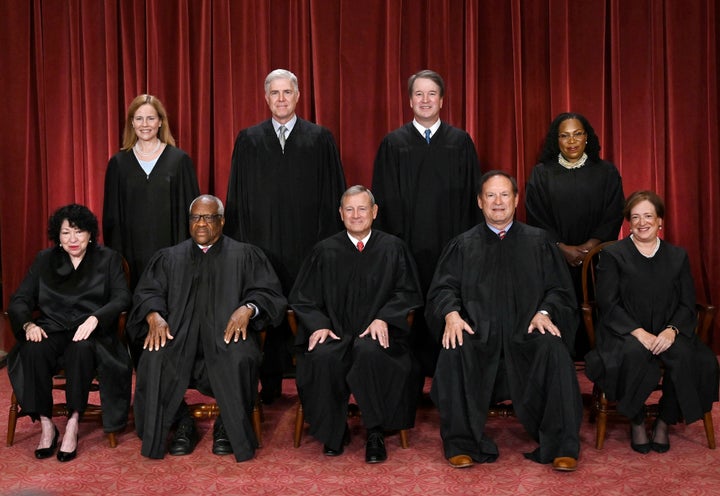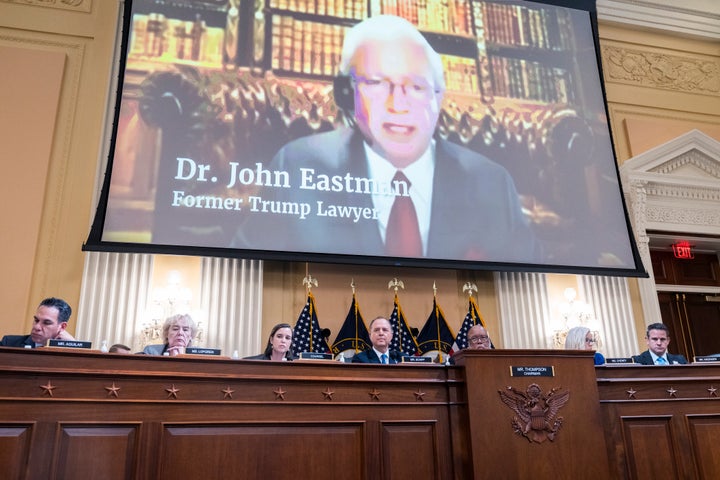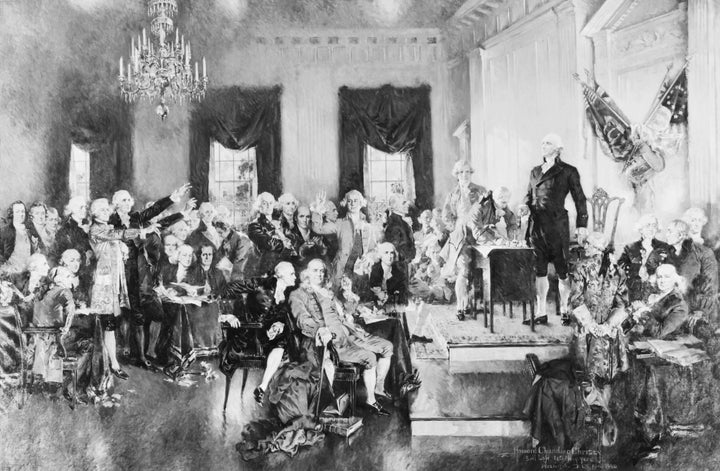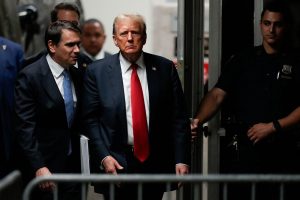
The in either accepting the theory or hearing a case on it. North Carolina’s challenge presented that opportunity and these four justices took up the case, even though the North Carolina legislature specifically authorized the state supreme court to adjudicate gerrymandering disputes in exactly the manner they now wish to invalidate.
Anti-Majoritarianism And Election Subversion
Perhaps the most glaring and stunning result that would immediately occur were the court to approve the theory is the complete reversal of its decision in Rucho just three years later. In Rucho, the court said that federal courts could not police claims of partisan gerrymandering, and so state courts and state constitutions must do so instead. But the independent state legislature theory says that state courts and state constitutions must also play no role. This would mean that there would be absolutely no check on partisan gerrymandering by state legislatures.
“You’d have no court in the country that could adjudicate these claims,” Eliza Sweren-Becker, counsel for the Brennan Center for Justice, a nonprofit that opposes the independent state legislature theory, said.
Advertisement

Tom Williams via Getty Images
This would enable already gerrymandered state legislatures to impose the most extreme partisan gerrymanders on their congressional delegations imaginable. This would turbo-charge the possibility of non-majoritarian rule in Congress. Some states, like North Carolina, Ohio and Wisconsin, already have wildly unrepresentative state legislatures despite having more closely split electorates. The adoption of the independent state legislature theory would only undermine the principle of majority rule that should underlie any republican form of government.
It could also lead to further efforts at subverting elections through attempts to overturn the will of the voters in presidential elections through the electoral college.
When Trump attempted to overthrow the elected government of Joe Biden through a subversion of the Electoral College, he did so using a false theory thought up by insurrectionist lawyer John Eastman that used the same independent state legislature theory but applied to the section of the constitution governing the appointment of presidential electors. He argued that state legislatures should appoint their own alternative slates of electors in contradiction of the actual vote of state residents. This is all part of an ongoing criminal investigation.
The issues raised in Moore v. Harper will not lead to the endorsement of Eastman’s false theories and the legal authorization of election subversion. There are laws and other constitutional provisions that keep Eastman’s preferred form of anti-democratic election subversion illegal even if the court accepted the independent state legislature theory.
Advertisement
The big problem that arises is that partisan state legislatures could use the confusion around this issue to engage in election subversion by submitting alternative electors anyways.
“Although a legislature’s attempt to appoint alternative slates of electors in these circumstances would violate both the Constitution and federal statutes, those seeking to undermine free and fair elections in the United States would only be further emboldened by a decision of this Court embracing Petitioners’ expansive view of state legislative power in federal elections,” Hasen argues in his brief.
It is no surprise that the same people who tried to overturn the 2020 election, including Eastman, Trump aides Stephen Miller and Mark Meadows, Trump’s former national security adviser Lt. Gen. Mike Flynn and Trump lawyer Cleta Mitchell filed briefs in support of the independent state legislature theory.
‘Historically Implausible’
The key question in Moore v. Harper is how the court defines the word “Legislature” in the Election Clause found in Article I of the Constitution.
“The Times, Places and Manner of holding Elections for Senators and Representatives, shall be prescribed in each State by the Legislature thereof; but the Congress may at any time by Law make or alter such Regulations, except as to the Places of [choosing] Senators,” the clause states.
Advertisement
The GOP petitioners argue in support of the theory that “Legislature” must mean the state legislature and only the state legislature, despite the word’s definition at the time and its interpretation ever since as meaning the whole of government. Their reading of this clause places state legislatures outside and above their respective state constitutions on the one issue of election law. They do not seek to use this definition of “Legislature” anywhere else in the Constitution.
The problem with their argument is that it has no basis in the history of the Constitution’s adoption and it makes no sense when considering how the authors of the Constitution viewed the idea of legislative supremacy.
“There is no evidence that anyone at the time expressed the view that Petitioners now espouse; nor would anyone have attempted to disprove an idea that had never been broached,” 10 historians of the founding era wrote in a friend of the court brief. “Petitioners’ interpretation is also historically implausible in view of the framers’ general fear of unchecked power and their specific distrust of state legislatures. There is no plausible eighteenth-century argument to support Petitioners’ view.”
“Every single state that adopted a constitution in the critical time period (late 1777 through 1793) or that otherwise squarely addressed the issue — nine states in all — openly contradicted Petitioners’ vision. No state embraced this vision,” originalist legal scholars Akil Amar, Vikram Amar and Calabresi wrote in a brief to the court.
“The Times, Places and Manner of holding Elections for Senators and Representatives, shall be prescribed in each State by the Legislature thereof; but the Congress may at any time by Law make or alter such Regulations, except as to the Places of chusing Senators.”
– U.S. Constitution, Article 1, Clause 4
Advertisement
The adoption of the federal constitution came, in part, in response to controversies arising from state legislatures having too much power under the Article of Confederation, the ten historians argue. This objection to state legislative supremacy led to a massive effort to write the federal and state constitutions to constrain state legislatures.
“American political leaders of the revolutionary era had a choice, they did not choose to empower freestanding legislatures as the basis of government,” the historians wrote. “Instead, they wrote individual state constitutions in which the legislature’s authority was subordinate to, and derived from, the authority of the state constitution, which in turn, received its authority from the people. Far from being independent, legislatures under the first state constitutions had no separate existence apart from the constitutions which created them.”
As it relates to the Elections Clause itself, no one involved in the constitutional ratification debate “ever implied that the Clause granted state legislatures unique authority to regulate congressional elections unconstrained by their state constitutions or the legal powers exercised by other branches of government,” the historians write. Not the Anti-Federalists who opposed the constitution, nor the Federalists who supported it.
North Carolina Republicans attempt to introduce an argument during ratification supporting their claims that the founding generation intended the Elections Clause to enshrine the independent state legislature theory by pointing out that South Carolina founder Charles Pinckney’s plan for a federal constitution and the alleged changes to it supports their theory.
“[T]he earliest draft of the Clause, proposed in the Philadelphia convention as part of the Pinckney Plan, would have [assigned responsibility to the States],” the petitioners in the case argue. “Crucially, however, the Committee of Detail deliberately changed the Constitution’s language to specify that state legislatures were to exercise that power, not any other state entity and not the state as a whole.”
Advertisement
Their argument rests on the belief that the Pinckney Plan represented the original constitutional language that was then changed to use the word “Legislature,” which they interpret as meaning the legislature and not the whole law-making body as was understood at the time.
The only problem: the Pinckney Plan they cite was not introduced during the ratification and has since been deemed “utterly discredited,” for over a hundred years.
During the ratification debates, South Carolina’s Charles Pinckney submitted his own plan for a federal constitution. There is no record of this plan and little evidence that it was even discussed during the Constitutional Convention. It did not appear in any written form until 1818 when Pinckney submitted it to John Quincy Adams when he was gathering documents from the convention for publication. And then James Madison and Rufus King disputed its veracity, with Madison arguing that there is “irresistible evidence that the plan as sent to Adams was never introduced,” at the convention.
The Pinckney Plan is “famously misleading document” that the petitioners use “to create an incorrect drafting history of the Elections Clause,” the historians argue.
“This portion of the Petitioner’s argument rests on a catastrophic misreading of the documentary record and a deliberation that is entirely imaginary,” the historians argue.
Advertisement
“Petitioners actually lead their brief with this fake and call this sham precursor to Article I, Section 4 “crucial[]” to their argument,” the Amars and Calabresi wrote.
The North Carolina Republicans “grossly exaggerate” Pinckney’s importance by citing his “bogus document,” they continue. This effectively makes the argument presented to the court in favor of the independent state legislature theory “phony.”
In conclusion, the founding era historians argue that, “There is no positive story one could tell—or even invent—to suggest the framers would have intended the Elections Clause to have so narrow and restrictive a meaning.”
‘Election Chaos’
Beyond the fact that the independent state legislature theory has no basis in the history of the country’s founding, or in the practice of election law over the ensuing 250 years, a raft of election administrators and election law scholars wrote to the court to explain the absolute chaos that would ensue if the court adopted the theory.
“What they want will mean election chaos,” Sweren-Becker said.
First, the adoption of the independent state legislature theory would unravel around 20 voter-enacted election laws, including non-partisan redistricting processes set up by citizen-backed ballot initiatives in 13 states and ranked-choice voting in Alaska and Maine, while sidelining 200 state constitutional provisions meant to protect the right to vote, the right to a secret ballot and the conduct of “free and fair elections,” according to a report by the redistricting reform group Represent.Us.
Advertisement

Bettmann via Getty Images
It would also overturn hundreds of state court decisions governing election law and thousands of regulations set by boards of elections, local election administrators and consent decrees governing everything from voter registration rules to polling locations to the procurement of voting machines.
Second, since the independent state legislature theory would only give state legislatures supremacy over federal elections, state and federal elections would then operate under different rules.
“[A]ttempting to administer concurrent federal-state elections under different rulebooks along with the inevitable increases in litigation would be an election administrator’s nightmare,” a bipartisan group of current and former election administrators wrote in a brief to the court. “Errors would be inevitable, administrative and training costs would soar, and the public’s confidence in our elections would dive.”
And, third, the closure of the state courts to election law litigation would lead to a massive increase in litigation over detail, major and minor, of election law in the federal courts.
Advertisement
“[E]ach routine state judicial or administrative act of gapfilling or interpretation would become the basis for a federal constitutional lawsuit based upon some alleged discrepancy between the statutory text and the interpretation and implementation of that text,” UCLA’s Hasen wrote in his brief to the court.
The federal courts are already burdened with an ever-increasing amount of election litigation. That litigation continues to drive public support for elections down, especially when it is taken advantage of and lied about by high-profile actors like former President Trump and the Republican Party.
With four conservative justices already on the record as supportive or sympathetic to the independent state legislature theory, the outcome of the case could rest on Justice Amy Coney Barrett. Barrett is the only conservative justice who was not party to the October 2020 decisions on the theory and, therefore, has no known public opinion on the issue. Roberts joined the court’s three liberals in March to reject emergency appeals from North Carolina and Pennsylvania seeking approval of the theory.
The court hears arguments at 10 a.m. on Wednesday, Dec. 7.




